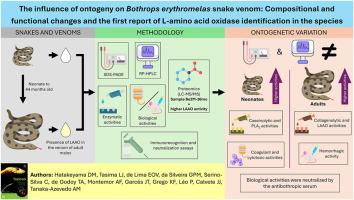个体发育对红melbothrops蛇毒的影响:该物种l -氨基酸氧化酶的组成和功能变化及首次报道。
IF 2.4
4区 医学
Q2 PHARMACOLOGY & PHARMACY
引用次数: 0
摘要
蛇咬伤因其全球影响而被列为被忽视的热带病。Bothrops属是巴西的主要感染源,具有局部性和全身性症状。蛇毒受到几种内部和外部因素的影响,包括个体发生。红melas Bothrops是一种具有多种食性的小蛇,其毒液的个体发生变异尚未完全阐明。因此,目前的工作旨在从生物学和生化特征的红melas b蛇的毒液从新生儿到成年。新生儿毒液的成分分析显示,其蛋白质谱以高分子质量带为主,随着动物的成熟而减少。相反,中、低质量蛋白质组成的区域随着年龄的增长而增加。在毒液的色谱图中,我们突出了主要由金属蛋白酶组成的区域的峰的移动,这可能与凝血和胶原溶解活性有关。有趣的是,在雄性成虫的毒液中检测到l -氨基酸氧化酶(LAAO)活性,因此将表现出最高活性的一个个体的毒液进行了质谱分析,首次证实了该物种毒液中存在l -氨基酸氧化酶。在活性方面,老年动物的胶原溶解、LAAO、出血性和致死活性较高,而磷脂酶A2、酪蛋白溶解、细胞毒性和凝血活性在新生动物和幼年动物中较高。免疫识别试验表明,成年蛇的毒液比年轻蛇的毒性更强。尽管如此,体外蛋白水解和凝血活性被部分抑制,而出血性活性几乎完全中和。这些结果,连同文献,强调了研究蛇毒种内变异的重要性,以加深我们对这些动物生物学的理解,并作为改进抗蛇毒血清治疗的手段。本文章由计算机程序翻译,如有差异,请以英文原文为准。

The influence of ontogeny on Bothrops erythromelas snake venom: Compositional and functional changes and the first report of L-amino acid oxidase in this species
Snakebites are classified as a neglected tropical disease due to its global impact. The genus Bothrops is the main responsible for envenoming in Brazil, with symptoms that are both local and systemic. Snake venoms are subject to intraspecific variation related to several internal and external factors, including ontogeny. Bothrops erythromelas are small snakes with generalist feeding habits and the ontogenetic variation in its venom has not yet been fully elucidated. Thus, the present work aimed to biologically and biochemically characterize the venom of B. erythromelas snakes from neonates to adults. Compositional analysis of neonates' venom showed a protein profile predominated by high molecular mass bands, which decreased as the animals matured. Contrarily, the regions comprising intermediate and low mass proteins increased in higher ages. In the chromatograms of the venoms, we highlight a shift of peaks in the region predominantly composed of metalloproteases, which may be related to coagulant and collagenolytic activities. Interestingly, L-amino acid oxidase (LAAO) activity was detected in the venom of male adults, so the venom of the one individual that presented the highest activity was submitted to mass spectrometry analysis, confirming its presence in the venom of this species for the first time. Concerning the activities, collagenolytic, LAAO, hemorrhagic, and lethal activities were higher in older animals, while phospholipase A2, caseinolytic, cytotoxic, and coagulant activities were higher in neonates and juveniles. The immunorecognition assay showed that the venoms of adults were more reactive than those of younger snakes. Nonetheless, proteolytic and coagulant activities in vitro were partially inhibited, whilst hemorrhagic activity were almost completely neutralized. These results altogether, along with literature, highlight the importance of studying intraspecific variation of snake venoms in order to deepen our understanding of the biology of these animals and as means to improve antivenom treatment.
求助全文
通过发布文献求助,成功后即可免费获取论文全文。
去求助
来源期刊

Toxicon
医学-毒理学
CiteScore
4.80
自引率
10.70%
发文量
358
审稿时长
68 days
期刊介绍:
Toxicon has an open access mirror Toxicon: X, sharing the same aims and scope, editorial team, submission system and rigorous peer review. An introductory offer Toxicon: X - full waiver of the Open Access fee.
Toxicon''s "aims and scope" are to publish:
-articles containing the results of original research on problems related to toxins derived from animals, plants and microorganisms
-papers on novel findings related to the chemical, pharmacological, toxicological, and immunological properties of natural toxins
-molecular biological studies of toxins and other genes from poisonous and venomous organisms that advance understanding of the role or function of toxins
-clinical observations on poisoning and envenoming where a new therapeutic principle has been proposed or a decidedly superior clinical result has been obtained.
-material on the use of toxins as tools in studying biological processes and material on subjects related to venom and antivenom problems.
-articles on the translational application of toxins, for example as drugs and insecticides
-epidemiological studies on envenoming or poisoning, so long as they highlight a previously unrecognised medical problem or provide insight into the prevention or medical treatment of envenoming or poisoning. Retrospective surveys of hospital records, especially those lacking species identification, will not be considered for publication. Properly designed prospective community-based surveys are strongly encouraged.
-articles describing well-known activities of venoms, such as antibacterial, anticancer, and analgesic activities of arachnid venoms, without any attempt to define the mechanism of action or purify the active component, will not be considered for publication in Toxicon.
-review articles on problems related to toxinology.
To encourage the exchange of ideas, sections of the journal may be devoted to Short Communications, Letters to the Editor and activities of the affiliated societies.
 求助内容:
求助内容: 应助结果提醒方式:
应助结果提醒方式:


